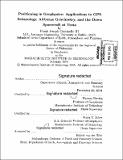| dc.contributor.advisor | Thomas Herring and Maria T. Zuber. | en_US |
| dc.contributor.author | Centinello, Frank Joseph, III | en_US |
| dc.contributor.other | Massachusetts Institute of Technology. Department of Earth, Atmospheric, and Planetary Sciences. | en_US |
| dc.date.accessioned | 2015-06-10T19:10:42Z | |
| dc.date.available | 2015-06-10T19:10:42Z | |
| dc.date.copyright | 2015 | en_US |
| dc.date.issued | 2015 | en_US |
| dc.identifier.uri | http://hdl.handle.net/1721.1/97333 | |
| dc.description | Thesis: Ph. D. in Geophysics, Massachusetts Institute of Technology, Department of Earth, Atmospheric, and Planetary Sciences, 2015. | en_US |
| dc.description | Cataloged from PDF version of thesis. | en_US |
| dc.description | Includes bibliographical references (pages 133-143). | en_US |
| dc.description.abstract | This dissertation presents improvements made on position estimation techniques applied to seismology, airborne gravimetry and planetary gravity recovery. In Chapters 2 and 3, a smoothed ionospheric model computed using GPS phase observations was applied to seismology and airborne gravimetry. The seismic investigation observed the 2010 El Mayor-Cucapah earthquake near Baja, California. The application of the ionospheric model resulted in an overall 4 mm RMS reduction in the measurements of GPS heights. The same ionospheric technique was applied to GPS data collected during an airborne gravity survey. In this study the model improved the RMS spread of four repeat gravity profiles by 0.6 mGal. Chapters 4 and 5 focus on the Dawn mission to the asteroid 4 Vesta. Chapter 4 details the use of spacecraft image constraints in the orbit determination software GEODYN, which is used by NASA/GSFC for trajectory reconstruction and geophysical analyses of planets. Image constraints are shown to converge an orbit solution that differs from that computed by the Dawn Science Team at JPL by less than 13 m. Chapter 5 describes the application of the new technique in the estimation of the orientation parameters and low-degree gravity field of Vesta. The pole orientation and low-degree gravity field estimated agree with that presented by the Dawn Science Team through the use of an independent software and estimation algorithm. | en_US |
| dc.description.statementofresponsibility | by Frank Joseph Centinello, III. | en_US |
| dc.format.extent | 143 pages | en_US |
| dc.language.iso | eng | en_US |
| dc.publisher | Massachusetts Institute of Technology | en_US |
| dc.rights | M.I.T. theses are protected by copyright. They may be viewed from this source for any purpose, but reproduction or distribution in any format is prohibited without written permission. See provided URL for inquiries about permission. | en_US |
| dc.rights.uri | http://dspace.mit.edu/handle/1721.1/7582 | en_US |
| dc.subject | Earth, Atmospheric, and Planetary Sciences. | en_US |
| dc.title | Positioning in geophysics : applications to GPS seismology, airborne gravimetry, and the Dawn Spacecraft at Vesta | en_US |
| dc.type | Thesis | en_US |
| dc.description.degree | Ph. D. in Geophysics | en_US |
| dc.contributor.department | Massachusetts Institute of Technology. Department of Earth, Atmospheric, and Planetary Sciences | |
| dc.identifier.oclc | 910513409 | en_US |
